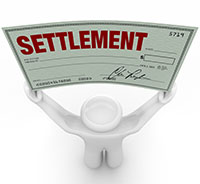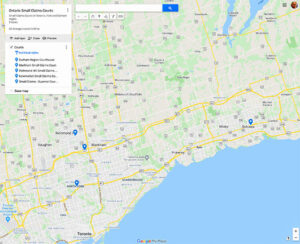Are you suing a person or business for money or property valued at $35,000 or less?
When you sue someone or a business in Small Claims Court, you are the Plaintiff. The person or business you are suing is the Defendant.
Before deciding to file a lawsuit (commonly referred to as a “claim”) in Small Claims Court, you need to seriously and factually consider the merits of your claim; the value of your time and money (including the cost of choosing to have representation); and the likelihood the defendant will be able to pay if you are successful.
Because of its inherent complexities and unknown contingent next steps, such legal services are typically billed on an hourly basis. And here’s why.
Broadly, there are five (5) distinct phases to a Small Claims Court claim.
If you are suing someone:
- The first phase as plaintiff:
- File a Statement of Claim against the defendant with the Small Claims court of jurisdiction within two (2) years of when you first learned about the issue (or ought to have known about the issue);
- Serve a copy of the Statement of Claim on the Defendant within six (6) months of filing the claim with the court;
- Complete an Affidavit of Service, which must then be commissioned by a paralegal or lawyer; and
- Submit the claim and the Affidavit of Service with the Small Claims Court where you filed the Statement of Claim.
- The second phase is two-pronged:
 If the Defendant does not file a defence within the stipulated timeframe, you can then file for a Default Judgement. This means first asking the Court Clerk to note the ‘defendant in default’ followed by filing a request for a Default Judgement from the court to order the Defendant to pay you the money you are owed without the participation of the defendant. This step may or may not involve filing a Notice of Motion and Supporting Affidavit or filing a Request to Clerk form to ask for an assessment hearing; OR
If the Defendant does not file a defence within the stipulated timeframe, you can then file for a Default Judgement. This means first asking the Court Clerk to note the ‘defendant in default’ followed by filing a request for a Default Judgement from the court to order the Defendant to pay you the money you are owed without the participation of the defendant. This step may or may not involve filing a Notice of Motion and Supporting Affidavit or filing a Request to Clerk form to ask for an assessment hearing; OR- If the Defendant files a defence within the stipulated timeframe, you will be served by the defence with a copy.
- The third phase:
- Where the Defendant has filed a defence, the court will send you a notice for a mandatory Settlement Conference. This step takes place between yourself and the Defendant in front of a judge. It gives you and the Defendant the right to be “heard”. Each side presents its side of the case with a view to settling the matter without a trial.
- The fourth phase is a Trial. This step occurs only if and after you and the Defendant are unable to come to a settlement.

- The fifth phase is Collection. If you are successful, it doesn’t mean you will automatically be paid by the Defendant. In some cases, it will be necessary for you to pursue further legal steps to receive any money you are entitled to by court order at the Settlement Conference stage or the Trial stage, as the case may be.
Are you or your business being sued by someone for money or property valued at $35,000 or less?
When someone or a business is suing you in Small Claims Court, you are the Defendant. The person or business suing you is the Plaintiff.
When you are served with a Small Claims Court lawsuit (commonly referred to as a “Claim”), you need to seriously, factually, and expeditiously consider your defence of the claim; the merits of the claim; and the value of your time and money (including the cost of choosing to have representation) to defend it.
Because of its inherent complexities and unknown contingent next steps, such legal services are typically billed on an hourly basis. And here’s why.
Broadly, there are three (3) distinct phases to a small claims court defence.
If you are being sued by someone:
- The first phase:
- File a Defence with the court within twenty (20) days following your being served with a Statement of Claim from the Plaintiff. In some instances, you may also wish to file your own claim, commonly referred to as a “Counterclaim”;
- Serve the Plaintiff with a copy of the Defence;
 Complete an Affidavit of Service, which must then be commissioned by a paralegal or lawyer; and
Complete an Affidavit of Service, which must then be commissioned by a paralegal or lawyer; and- Submit the Defence and the Affidavit of Service to the Small Claims Court where you filed the Defence.
- The second phase:
- After you have filed your Defence, the court will send you a notice for a mandatory Settlement Conference. This step takes place between yourself and the Plaintiff in front of a judge. It gives you and the Plaintiff the right to be “heard.” Each side presents its side of the case with a view to settling the matter without a trial.

- The third phase is a Trial. This step occurs only if and after you and the Plaintiff are unable to come to a settlement.
More information on Small Claims court procedures can be found at:
Small Claims Court Locations
| Court Name | Address | Telephone |
| Toronto Small Claims Court | 47 Sheppard Ave. East, Toronto, ON, M2N 5N1 | 416-326-3592 |
| Newmarket Small Claims Court | 50 Eagle Street West, Newmarket, ON, L3Y 6B1 | 905-853-4809 |
| Durham Region | 150 Bond Street East, Oshawa, ON, L1G 0A2 | 905-743-2630 |
| Markham Small Claims Court | 8500 Leslie St., Suite 395, Markham, ON, L3T 7M8 | 905-731-2664 |
| Richmond Hill Small Claims Court | 855 Major Mackenzie Drive East, Richmond Hill, ON, L4B 4X7 | 905-731-2664 |
Durham Region includes: Ajax, Brock, Clarington, Oshawa, Pickering, Scugog, Uxbridge & Whitby

 Click for detailed map
Click for detailed map